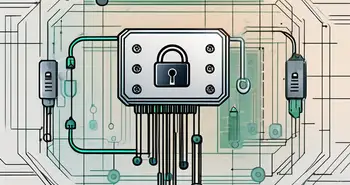Appchains: The Future of Specialized Blockchain Networks

I have been working in the field of blockchain technology for years, and I am excited to share with you everything you need to know about one of its most fascinating innovations: appchains. In this ultimate guide, we will dive deep into the basics, technical aspects, benefits, potential drawbacks, and answer some frequently asked questions. So, let's get started!
Understanding the Basics of Appchains
Definition and Function of Appchains
Appchains, also known as “sidechains,” are independent chains that run parallel to the main blockchain. They offer a solution for specific decentralized applications (DApps) that require a higher level of customization and scalability. Appchains provide a dedicated environment where developers can create and deploy their applications, making them flexible and efficient.
Imagine a separate highway next to the main road, exclusively reserved for certain types of vehicles. Appchains work similarly, allowing specific applications to operate more smoothly and independently from the main blockchain network. This separation ensures that DApps can have their own rules, consensus mechanisms, and token economics.
For example, let's consider a decentralized gaming application that requires fast transaction speeds and unique in-game assets. By utilizing an appchain, developers can design a gaming environment that is optimized for these specific requirements. This allows players to enjoy a seamless gaming experience without being hindered by the limitations of the main blockchain.
The Evolution of Appchains
The concept of appchains evolved from the limitations faced by traditional blockchains in terms of scalability and customization. Blockchain technology has made significant strides, but as more DApps are being developed, the need for specialized environments for different use cases became evident. Appchains bridge this gap by providing tailored solutions for various industries like finance, gaming, supply chain, and more.
I remember when the first appchains were introduced. It was a revolution in the blockchain space, as developers could now build applications with their unique set of rules and requirements. This level of customization opened up endless possibilities and led to a wave of innovation across multiple sectors.
Take the finance industry, for instance. With appchains, financial institutions can create their own blockchain-based systems that offer faster transaction speeds, improved security, and enhanced privacy. This allows for seamless cross-border transactions and the development of innovative financial products that were previously unimaginable.
Key Components of Appchains
Appchains consist of three key components: the parent blockchain, the appchain itself, and a two-way pegging mechanism.
- The parent blockchain serves as the main chain, providing security and consensus for all the appchains.
- The appchain operates independently, with its own set of rules and functionality.
- The two-way pegging mechanism enables the transfer of assets between the parent blockchain and the appchain, ensuring interoperability.
These components work together to create a symbiotic relationship between the parent blockchain and the appchain, allowing for seamless interaction and secure asset transfers.
Let's delve deeper into the two-way pegging mechanism. This mechanism ensures that assets can be moved between the parent blockchain and the appchain without any loss of value or security. It establishes a trustless bridge that enables users to transfer their tokens or assets back and forth, providing liquidity and flexibility.
Moreover, the two-way pegging mechanism also plays a crucial role in maintaining the overall security of the appchain. By pegging assets to the parent blockchain, any malicious activity or tampering within the appchain can be detected and addressed, ensuring the integrity of the entire system.
The Technical Aspects of Appchains
How Appchains Work
Appchains leverage the power of blockchain technology to create dedicated environments for specific applications. They function as separate chains, running in parallel to the main blockchain. This parallel processing allows for increased scalability and improved performance.
When a transaction or smart contract is initiated on an appchain, it is validated and processed within the appchain's network. Once the transaction is confirmed, the necessary information is recorded on the parent blockchain. This architecture ensures that appchains can operate independently while still benefiting from the security and consensus of the parent blockchain.
The Role of Blockchain in Appchains
The underlying technology behind appchains is blockchain. The parent blockchain provides a secure and decentralized foundation for appchains to operate. It guarantees the integrity of transactions and prevents any malicious activities that could compromise the appchain's functionality.
The immutability and transparency of blockchain ensure that all transactions and operations within appchains can be audited and verified. This level of trust is crucial, especially in sectors where accountability and transparency are paramount, such as finance and supply chain management.
Security Measures in Appchains
Appchains implement various security measures to protect the integrity of the network and the assets stored within. One of the primary security features is the use of consensus algorithms. These algorithms ensure that all participants in the network agree on the validity of transactions and prevent any malicious actors from compromising the system.
Additionally, appchains employ encryption techniques to secure data and prevent unauthorized access. Smart contract audits and code reviews are also conducted to identify and fix potential vulnerabilities before they can be exploited.
The Benefits of Using Appchains
Efficiency and Speed
One of the most significant advantages of appchains is their ability to enhance scalability and speed. By separating specific applications into their dedicated chains, appchains can process transactions and execute smart contracts more efficiently. This streamlined approach minimizes congestion on the main blockchain and allows for faster transaction confirmations.
Moreover, appchains enable developers to optimize their applications based on their specific needs. They can choose consensus mechanisms and network parameters that best suit their use case, resulting in improved overall performance.
Security and Transparency
Appchains offer a high level of security due to their reliance on blockchain technology. The decentralized nature of the parent blockchain, coupled with encryption measures, ensures that all transactions and data are stored securely and cannot be tampered with.
Transparency is another key benefit of appchains. With every transaction being recorded on the blockchain, all participants can easily track and verify the history of assets and operations. This transparency fosters trust and eliminates the need for intermediaries, reducing costs and friction in various industries.
Scalability and Interoperability
Scalability has long been a challenge for traditional blockchains. However, with appchains, this issue is effectively addressed. By segmenting applications into their dedicated chains, appchains significantly increase the capacity and throughput of the overall ecosystem.
Interoperability is also a key advantage of appchains. The two-way pegging mechanism allows for seamless asset transfers between the parent blockchain and the appchain. This interoperability enables collaboration between different applications and facilitates the exchange of value across various chains, promoting innovation and integration.
Appchain Ecosystems
Several blockchain ecosystems have embraced the concept of Appchains, providing the infrastructure and tools necessary for developers to build and deploy these specialized blockchains. Some of the most prominent Appchain ecosystems include:
-
Polkadot
- Polkadot is a multi-chain network that supports the creation of Appchains through its parachains. Parachains are independent blockchains that run in parallel within the Polkadot network, sharing the security of the Polkadot Relay Chain. This allows Appchains on Polkadot to benefit from the network’s scalability and interoperability while maintaining their independence and specialization.
-
Cosmos
- Cosmos is another leading ecosystem for Appchains, enabling the creation of independent blockchains that can communicate with each other through the Cosmos Hub. The Cosmos SDK provides developers with the tools to build custom blockchains, known as zones, which can then connect to the broader Cosmos network via the Inter-Blockchain Communication (IBC) protocol. This setup allows for seamless data and asset transfers between different Appchains within the Cosmos ecosystem.
-
Avalanche
- Avalanche is a platform that supports the creation of custom blockchains called subnets. Subnets are groups of validators that work together to achieve consensus on a specific blockchain within the Avalanche network. This flexibility allows developers to create Appchains with unique consensus mechanisms, governance models, and economic rules, all while benefiting from Avalanche’s high throughput and low latency.
Use Cases for Appchains
The versatility of Appchains makes them suitable for a wide range of applications across various industries. Here are some notable use cases:
-
Decentralized Finance (DeFi)
- In the DeFi space, Appchains can be designed to optimize transaction speeds and reduce costs, enabling more efficient trading, lending, and borrowing platforms. By avoiding the congestion of general-purpose blockchains, DeFi Appchains can offer users a smoother and more cost-effective experience.
-
Gaming
- The gaming industry can greatly benefit from Appchains, as they can be customized to handle high transaction volumes with minimal latency. This ensures that in-game transactions, such as the purchase of virtual assets or the execution of complex game mechanics, occur seamlessly, providing a better user experience.
-
Social Networks
- Social media platforms built on Appchains can prioritize user privacy and data ownership, allowing users to have greater control over their personal information. Additionally, Appchains can implement specialized governance models that empower users to participate in decision-making processes, creating a more democratic and user-centric social network.
-
Supply Chain Management
- Appchains can be tailored to track the movement of goods through a supply chain, ensuring transparency and accountability at every step. By recording transactions and events on a dedicated blockchain, companies can enhance the traceability of their products and reduce the risk of fraud.
Potential Drawbacks of Appchains
Technical Challenges
Like any cutting-edge technology, appchains come with their set of technical challenges. Implementing and maintaining appchains require expertise and resources. The development of robust consensus algorithms, efficient scaling solutions, and secure code is crucial to ensure the smooth functioning of appchains.
Moreover, the introduction of appchains adds complexity to the overall blockchain ecosystem. Coordinating different chains and ensuring seamless interoperability can be a significant undertaking, requiring the collaboration of various stakeholders.
Regulatory Concerns
As appchains enable the creation and deployment of decentralized applications, they also raise regulatory concerns. Governments and regulatory bodies are still catching up with the rapid advancements in blockchain technology, and the specific rules and regulations governing appchains may vary across jurisdictions.
It is essential for developers and businesses operating in the appchain space to stay informed about legal and compliance requirements to avoid any regulatory issues in the future.
Adoption and Acceptance Issues
Although appchains provide innovative solutions, their adoption and acceptance might take time. Educating developers, enterprises, and end-users about the benefits and capabilities of appchains is crucial to drive widespread adoption.
Fostering collaboration between different blockchain projects and industries can also help accelerate the acceptance of appchains as a viable solution. Working together to address common challenges and showcasing success stories will demonstrate the value that appchains bring to the table.
FAQs (Frequently Asked Questions)
What are appchains?
Appchains, also known as sidechains, are independent chains that operate alongside the main blockchain. They provide customized environments for decentralized applications, allowing for improved scalability and performance.
How do appchains work?
Appchains function by processing transactions and executing smart contracts within their independent network. Once a transaction is confirmed, the relevant information is recorded on the main blockchain. This architecture ensures independence while benefiting from the security of the main chain.
What are the benefits of using appchains?
Appchains offer enhanced efficiency, speed, security, transparency, scalability, and interoperability. They allow developers to optimize their applications, reduce congestion on the main blockchain, and seamlessly exchange assets between different chains.
What are the potential drawbacks of appchains?
Appchains present technical challenges, such as developing robust consensus algorithms and ensuring seamless interoperability. Regulatory concerns and the need for widespread adoption may also pose challenges in the appchain space.
Is there a future for appchains?
Indeed, appchains have a promising future. As blockchain technology continues to evolve, appchains will play a crucial role in providing tailored solutions for various industries. With ongoing research and development, the challenges associated with appchains will be overcome, leading to widespread adoption and acceptance.
In conclusion, appchains are revolutionizing the blockchain landscape by offering customized, scalable, and efficient solutions for decentralized applications. With their ability to enhance security, transparency, and interoperability, appchains are poised to drive innovation and reshape industries across the globe. As an expert in the field, I encourage developers, businesses, and enthusiasts to explore the potential of appchains and embrace the future of decentralized applications.
As we embrace the future of decentralized applications with appchains, it's essential to have the right tools to participate in this innovative landscape. Morpher is at the forefront of this revolution, offering a unique trading platform that harnesses the power of blockchain to provide zero fees, infinite liquidity, and a host of other features like fractional investing, short selling, and up to 10x leverage. Ready to take your trading to the next level with Morpher's groundbreaking technology? Sign Up and Get Your Free Sign Up Bonus today to start trading across a multitude of asset classes on a platform designed for the modern investor.

Disclaimer: All investments involve risk, and the past performance of a security, industry, sector, market, financial product, trading strategy, or individual’s trading does not guarantee future results or returns. Investors are fully responsible for any investment decisions they make. Such decisions should be based solely on an evaluation of their financial circumstances, investment objectives, risk tolerance, and liquidity needs. This post does not constitute investment advice.

Painless trading for everyone
Hundreds of markets all in one place - Apple, Bitcoin, Gold, Watches, NFTs, Sneakers and so much more.

Painless trading for everyone
Hundreds of markets all in one place - Apple, Bitcoin, Gold, Watches, NFTs, Sneakers and so much more.









